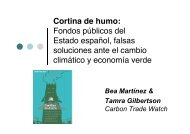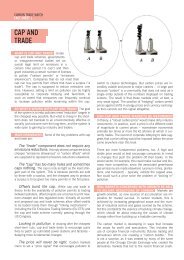The Sky is Not the Limit: - Carbon Trade Watch
The Sky is Not the Limit: - Carbon Trade Watch
The Sky is Not the Limit: - Carbon Trade Watch
- No tags were found...
Create successful ePaper yourself
Turn your PDF publications into a flip-book with our unique Google optimized e-Paper software.
2. <strong>The</strong> Origins of Em<strong>is</strong>sions Trading2.1 <strong>The</strong> Rio Earth Summit & ClimateChange<strong>The</strong> United Nations FrameworkConvention on Climate Change(UNFCCC) was one of <strong>the</strong> majoragreements to come out of <strong>the</strong> EarthSummit in 1992. <strong>The</strong> text of <strong>the</strong>UNFCCC was prepared in <strong>the</strong> yearsbefore <strong>the</strong> actual Earth Summit andwent through final negotiations in Rio,where it was adopted. 1Despite some obvious good qualities(see box), <strong>the</strong> UNFCCC did notinclude any commitment to legallybinding em<strong>is</strong>sion reductions. Nor did itrecogn<strong>is</strong>e <strong>the</strong> role of industry, overconsumptionand free trade policies inexacerbating climate change. Whydidn’t <strong>the</strong> UNFCCC, and <strong>the</strong> o<strong>the</strong>r Rioagreements for that matter, have anyteeth? <strong>The</strong> answer lies in <strong>the</strong> complexinteraction between government selfinterest,corporate influence and <strong>the</strong>r<strong>is</strong>e in popularity of “multi-stakeholder”processes.From <strong>the</strong> beginning of internationald<strong>is</strong>cussions about climate changeNor<strong>the</strong>rn governments have beenopposed to <strong>the</strong> structural changesneeded to truly combat <strong>the</strong> problem.Before <strong>the</strong> Earth Summit, <strong>the</strong>International Negotiating Committee(INC) was set-up to formulate aproposal text for Rio. Within <strong>the</strong> INC,both <strong>the</strong> US and <strong>the</strong> EU arguedagainst binding reductions ingreenhouse gases. 2Key Principles of <strong>the</strong> UNFCCCIn summary, <strong>the</strong> UNFCCC <strong>is</strong> arecognition of key principles regardingclimate change. <strong>The</strong>se principlesformed <strong>the</strong> framework for negotiationsthat eventually produced <strong>the</strong> KyotoProtocol in 1997. <strong>The</strong> UNFCCC;• Set an “ultimate objective” ofstabil<strong>is</strong>ing “greenhouse gasconcentrations”;• Establ<strong>is</strong>hed a framework and aprocess for agreeing to specificactions - later;• Encouraged scientific research onclimate change;• Placed greater responsibility forbattling climate change on <strong>the</strong> richcountries;• Recogn<strong>is</strong>ed that poorer nations havea right to economic development;• Acknowledged <strong>the</strong> vulnerability ofpoorer countries to <strong>the</strong> effects ofclimate change;• Called for <strong>the</strong> sharing ofenvironmentally sound technologiesand know-how; and• Emphas<strong>is</strong>ed <strong>the</strong> need to educatepeople about climate change. 4“Ten years ago at <strong>the</strong> RioSummit, 50 business leaderspledged a commitment tosustainable development.That was <strong>the</strong> start of <strong>the</strong>WBCSD. Since <strong>the</strong>n, wehave trebled in size andhugely amplified <strong>the</strong> voice ofbusiness in widespreaddialogue.”— Philip Watts, WBCSDchairperson 3• Recogn<strong>is</strong>ed that climate change <strong>is</strong> aproblem;12











